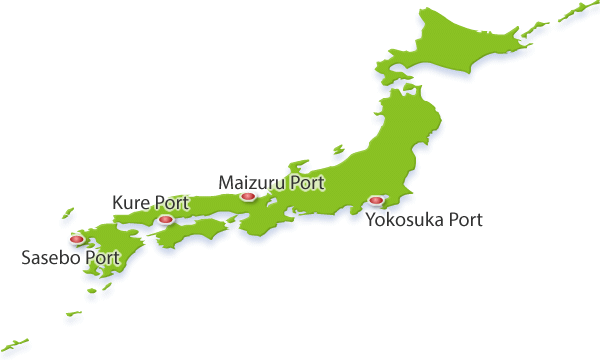Four Cities of Former Naval Ports

Up until the Meiji era, the four cities of the former naval ports (Yokosuka City, Kure City, Sasebo City, and Maizuru City) developed as seaside towns and villages with their own industries and cultures. At the start of the Meiji era, the ‘Chinju-fu (naval station)’ division of the navy was set up in these towns and they were grown as naval port cities.
- Meiji 17 (1884) Start of naval station operation in Yokosuka
- Meiji 22 (1889) Start of naval station operations in Kure and Sasebo.
- Meiji 34 (1901) Start of naval station operation in Maizuru.
As a result of opening these naval stations, the populations of these four cities kept on growing and various facilities such as docks, large cranes, red-brick warehouses, and water supply facilities were constructed. Today, these facilities pass on their histories to visitors as monuments to the modernization period.
When the Second World War ended, however, the four cities, which had advanced as naval port cities, lost the heart of their existence and their population declined sharply.
Dealt with a catastrophic blow, the four cities took a decision to transform themselves into peace-time industrial coast cities taking advantage of former military assets as a way to restoration and urban regeneration.
A law called “Act on Reconstruction of Cities that Formerly Served as Naval Ports” expressly applied to these four cities was enacted by a legislation proposed by lawmakers in the Japanese Diet and a local referendum in each city, and this law proclaimed and enforced in 1950.
This naval port reconstruction law stipulated special measures, for example, the transfer of former military assets free of charge or at nominal cost.
Due to the enactment of the above naval port reconstruction law, many former military assets were converted and utilized as public facilities (such as schools, parks, roads, and commercial ports) and land for private facilities that would provide industrial and economical support for the cities.
After the War, the four cities that had developed as naval ports were born again as peace-time industrial coast cities.
Even today, 70 years after the War, the transfer and utilization of all former military assets are not completed yet.
At this milestone 70th anniversary year, the four former naval port cities shall work hand in hand to take bold new steps.
To be more specific, we will take advantage of the monuments to the modernization period that have served as the foundation of the modernization of Japan and development of the four cities, draw out the appeal of the present-day towns to the maximum, and publicize information about the attractions of these four cities to people in Japan and the world.
Challenges of four former naval ports
Cities tied with ocean and history
Towards peace-time tourism coast cities













